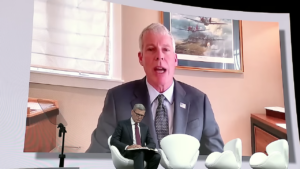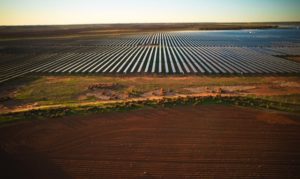 New South Wales Premier Gladys Berejiklian has become the latest Conservative politician to flag possible government intervention to keep one of the nation’s oldest and least reliable coal power plants open past its use-by date.
New South Wales Premier Gladys Berejiklian has become the latest Conservative politician to flag possible government intervention to keep one of the nation’s oldest and least reliable coal power plants open past its use-by date.
On the same day of news of another trip at the Liddell coal fired generator – described by analysts as being “clapped out” – Berejiklian is speaking of keeping it open “as a way of guaranteeing cheap and reliable electricity for the state.”
The Daily Telegraph broke the news on Thursday, saying it was “heartened” to note that Berejiklian had opened the door “ever so slightly” to preventing the closure of the Hunter Valley coal plant, during an interview with the paper’s own conservative columnist Miranda Devine.
“Potentially there’s a whole range of options that we’re looking at,” the premier was quoted as saying to Devine, in reference to the privately owned plant’s scheduled closure. “I don’t want to say too much.”
This is, and isn’t surprising.
It is not surprising in that the increasingly rickety AGL Energy owned coal plant – which is slated to be closed on its 50th birthday in 2022 – has become the unlikely poster child of conservative politicians and media pundits who want their power coal-fired, and/or sourced from anything but renewables, thank you very much.
Numerous LNP members, both state and federal, have called for the plant to be kept open, going right to the top, when Prime minister Malcolm Turnbull confidently told Question Time in Septemeber that the Coalition would ask AGL Energy to keep Liddell open another five years beyond 2022, as a matter of national energy security.
What is surprising is that nothing – not the plant’s numerous unscheduled breakdowns and blow-ups; not AGL Energy’s swift and consistent message back to the PM that “Keeping old coal plants open won’t deliver the reliable, affordable energy our customers need;” not the projected $1 billion cost of keeping Liddell open; and not the global shift to cheaper and cleaner renewable energy and enabling technologies – seems to shake their belief that this might happen.
Never mind that AGL has confirmed its plans to close Liddell and replace it with 1.6GW of renewables, plus storage and other technologies – a plan the company argues is a smarter, cheaper, cleaner and more reliable option than keeping the ageing and unreliable coal plant open.
How much cheaper? AGL has estimated it would have to invest $920 million to keep Liddell open another five years, pushing the cost of its output up to around $106/MWh.
As Giles Parkinson noted here in December, this compares to just $83/MWh for the renewable-focused portfolio, including storage and some (expensive) gas peakers. That wholesale price also compares to an average cost of wholesale electricity in NSW in 2017 of around $100/MWh.
Meanwhile, the old coal plant continues to demonstrate that it is anything but reliable. Just this Tuesday, a unit at the plant failed unexpectedly, taking more than 400MW of scheduled capacity with it. Again, not surprising, for a generator that, as The Australia Institute put it yesterday, “predates colour TV in Australia.”
As we reported, one of the plant’s four units has been out of action for most of the summer after broken turbine blades took unit 1 (420MW) out of the market in mid-December. At that time, the number 2 unit at Liddell had not operated since early August.
But the Murdoch tabloids are relentless. This week, columnist Terry McCrann was doing his level best to convince himself and his readers that last week’s wholesale electricity price spikes were all the fault of renewables.
But just like energy minister Josh Frydenberg, his explanation completely ignored the prime cause of the first of those two price spikes – the sudden trip of Loy Yang B and the immediate loss of 530MW of capacity.
Price rises don’t happen by themselves. They happen because of the bidding actions of the dispatchable generators – the coal, gas and hydro plants.
And whenever there is an unexpected outage, or money to be made from a market constraint – they push prices into orbit.
It’s the exact opposite of what happens in other markets. Normally when you buy goods in bulk, you get a discount. In electricity, if you want to get more out of a fossil fuel plant, you have to pay 10-20 times more.
McCrann could have also made mention of two huge price spikes in Queensland – a state still largely free of large scale wind and solar – a week earlier, the first one caused by trips of a major coal unit and a unit at the most recently built gas plant, and the second by “technical” issues with a pumped hydro plant. Might not have fitted the theme.
In other news, the Guardian reports today that new data has revealed that “advertisements spruiking the benefits of coal and mining were the biggest political expenditure by third-party groups in Australia last year, dwarfing public contributions from unions and GetUp.”
According to Australian Electoral Commission disclosures, the biggest political expenditure was $3.6 million by ACA Low Emissions Technologies Ltd, which manages a fund established by the coal industry to invest in clean coal. The Minerals Council spent $1.3 million.
Note: Asked for comments on the Premier’s remarks, energy minister Don Harwin said in a statement emailed to RenewEconomy that:
“The NSW Government is developing with COAG Energy Council a sensible national plan to secure new investment in a mix of energy sources.
“The National Energy Guarantee is the key policy for our energy security.
“NSW has a huge pipeline of projects under construction that will boost supply and put downward pressure on prices.
“The Australian Energy Market Operator is currently assessing whether the new generation proposed will replace Liddell’s output, and we look forward to receiving their report.
“The NSW Energy Security Taskforce has said that NSW is well placed for this summer under normal circumstances.”










